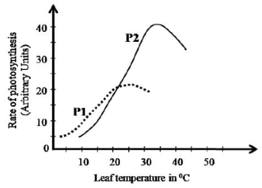Organization for Matter and Energy Flow in Organisms - The process of photosynthesis converts light energy to stored chemical energy by converting carbon dioxide plus water into sugars plus released oxygen.
Organization for Matter and Energy Flow in Organisms - The process of photosynthesis converts light energy to stored chemical energy by converting carbon dioxide plus water into sugars plus released oxygen.: Overview
This topic covers various concepts like Absorption Spectrum, , etc.
Important Questions on Organization for Matter and Energy Flow in Organisms - The process of photosynthesis converts light energy to stored chemical energy by converting carbon dioxide plus water into sugars plus released oxygen.
During glycolysis in cytoplasm, the decarboxylation reactions -----------------.
Select the incorrect statement
What is PAR range?
Which one of the following categories of organisms do not evolve oxygen during photosynthesis?
Blackman's law of limiting factor is applied to
Assertion : Cyclic pathway of photosynthesis first appeared in some eubacterial species.
Reason : Oxygen started accumulating in the atmosphere after the non-cyclic pathway of photosynthesis evolved.
Which of the following is most appropriate for aerobic respiration?
Which of the following is/are produced by a plant during photosynthesis with far-red light?
The following plot represents the change in the rate of photosynthesis with leaf temperature for two plants, P1 and P2.

Which one of the following statements correctly describes the characteristics of P1 and P2 plants?
Match List I with List II:
|
List I |
List II |
| A. Oxidative decarboxylation | I. Citrate synthase |
| B. Glycolysis | II. Pyruvate dehydrogenase |
| C. Oxidative phosphorylation | III. Electron transport system |
| D. Tricarboxylic acid cycle | IV. EMP pathway |
Choose the correct answer from the options given below:
Which of the following combinations is required for chemiosmosis?
A lower value of pH is maintained in the lumen of thylakoid of chloroplasts is due to:
I. Movement of protons across the membrane through CF0 channel.
II. Release of protons by proton carrier into the lumen.
III. Oxidation of water molecule.
IV. Reduction of NADP+ towards stroma.
Why is NADPH not formed during cyclic photophosphorylation?
When one CO2, molecule is fixed as one molecule of triose phosphate, which of the following photochemically made, high energy chemical intermediates are used in the reduction phase?
Identify the correct statement about thylakoid membrane that makes those the sites of light-dependent reaction in photosynthesis.
(i) Carbon dioxide and water can diffuse through the thylakoid membrane.
(ii) Photosystem-II anchored to the thylakoid membrane is involved in both cyclic and non-cyclic photophosphorylation.
(iii) Cytochrome complex embedded in the thylakoid membrane creates proton gradient.
(iv) Thylakoid membrane with pigment and protein complexes has the capability of harvesting light.
What is respiration? Give the mechanism of aerobic and anaerobic respiration.
A student working in a lab had three tubes with the following preparations:
(i) Freshly extracted nucleic acids dissolved in a buffer.
(ii) Chlorophyll extracted from spinach leaf.
(iii) Red coloured anthocyanin from onion cells.
The student used a spectrophotometer to determine the wavelength of light at which each preparation would show maximum absorption (absorption spectrum). She noted down the values in her notebook. However, when she came to the lab the next day, she realised that she had not mentioned the name of the sample preparation against each value. The values she recorded were 480 nm, 260 nm, and 642 nm. The respective values for the sample (i), (ii), and (iii) would most likely be:
Choose the incorrect statement from the following:
Which of the following statements are false regarding photorespiration?
A) Synthesis of neither sugars nor ATP occur in photorespiration.
B) Photorespiration does occur in plants due to concentration of at the active site of .
C) In photorespiration, molecules of PGA are formed from a molecule.
D) In plants, photorespiration is responsible for decreased productivity.
Which of the following statements are false regarding plants?
A) plants lack photorespiration and have lesser biomass production.
B) Bundle sheath cells contain large number of chloroplasts.
C) Mesophyll cells consists of enzyme.
D) The primary acceptor is a -carbon molecule.
